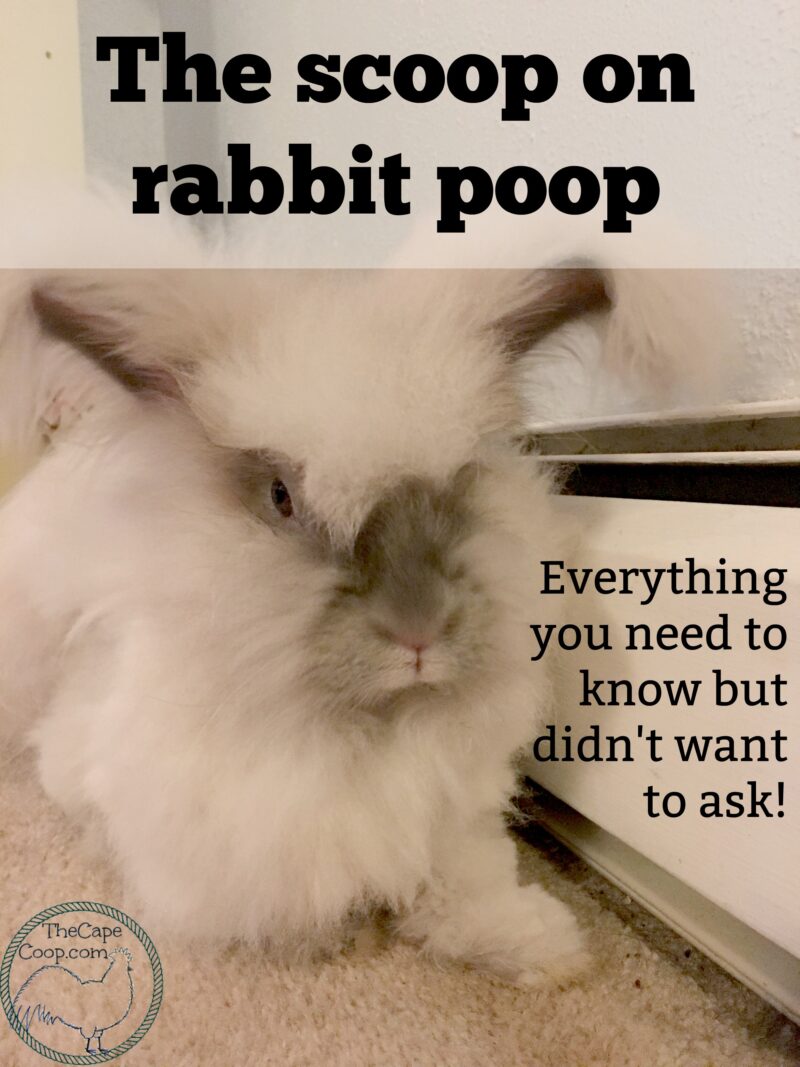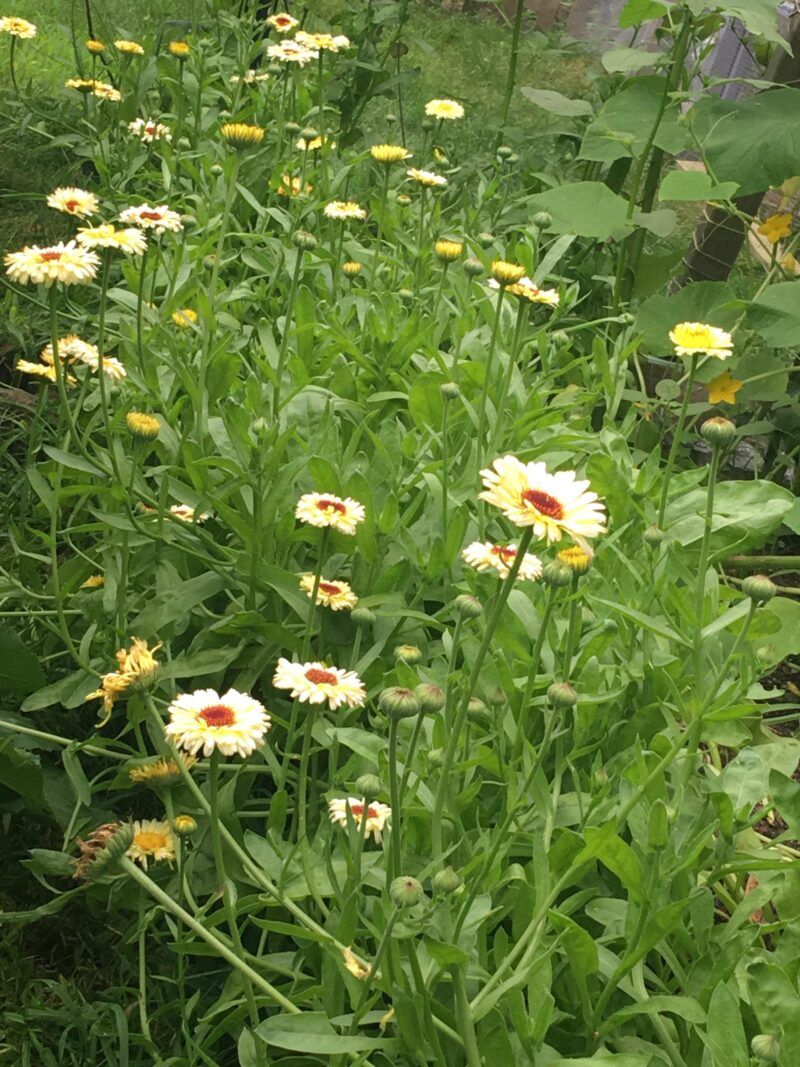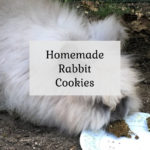---------------------------------------------------------
I know, I know – who wants to read about poop? Any good animal keeper knows that your critter’s poop can tell you all kinds of important information about the health of your animal. Rabbits are no exception. As animals that live at the bottom of the food chain, they excel at hiding illness. Rabbit keepers need to pay attention to subtle changes. It might not be pleasant, but until we learn how to speak rabbit, “reading” your bunny’s poop is the next best thing to hearing them say “I’m not feeling well”. (speaking of rabbit language, click here to check out my article on reading rabbit behavioral cues)
Two kinds of poop
Healthy rabbits produce two kinds of droppings. The first, and most frequent droppings are the dry, round fecal pellets you (hopefully!) find in the litter box. Fecal pellets should be plentiful and fairly uniform in shape & size. Up to 100 or more fecal pellets a day per bunny is totally normal. When they are fresh, they might be a little soft, but for the most part, they should be firm, round, & dry.

The second kind of dropping are cecotropes. These droppings are actually not feces, but tiny nutrient-rich powerhouses that are necessary for rabbit health. Cecotropes are formed in a special part of the rabbit’s digestive tract called the cecum. After passing through the small intestine, food that is done digesting is sent to the large intestine to be processed as fecal pellets. The food that is undigested is passed to the cecum where a large population of healthy bacteria, yeasts, and microorganisms work to break down the food into a digestible form.
The resulting cecotrope is a condensed, nutrient & microbe rich dropping that the rabbit will eat. I know it seems really disgusting, but your rabbit does not think so! Rabbits that do not eat their cecotropes can eventually become malnourished. You will likely not notice her munching on her droppings as they tend to eat them immediately as they excrete them. You might see your rabbit reaching underneath himself like he is grooming, but will come up chewing something. Cecotropes are soft, shiny & dark in color; clustered together like blackberries. They also smell considerably more than the fecal pellets!
Poop problems
No droppings
If your rabbit stops producing droppings of any kind, her digestive system may have stopped processing food either because it is clogged or infected. This is a life-threatening emergency! You should seek immediate veterinary care! For more information on GI Stasis in rabbits, click here
Strange shapes
Fecal pellets should be round & fairly uniform in size (about the size of a pea). If your rabbit’s poop is suddenly small, misshapen, or really hard it usually means he is not getting enough fiber in his diet. Make sure unlimited hay is available and plenty of cool, fresh water
String of poop
Especially common in long-haired rabbits, if they ingest too much fur, the fecal pellets can occasionally come out strung together like a necklace. Finding an occasional string isn’t concerning when keeping long-haired rabbits (especially during a shedding period). If you find more than one a week, you should step up your grooming schedule.

Excess cecotropes
In a healthy, adult rabbit, you likely won’t see many cecotropes because they eat them as they come out. A diet too high in carbs or sugar can upset the balance in the caecum and cause your bunny to produce too many. This is usually the result of offering unlimited pellets or too many treats. Not only should you take this as your cue that something is amiss with your rabbit’s diet, but from a sanitary standpoint you don’t want excess cecotropes around. They usually end up smooshed onto the floor or stuck to your rabbit’s fur – yuck! It is totally normal to find them from time to time, but it shouldn’t be a regular occurrence. click here for tips on feeding your rabbit
If your rabbit can not reach all the way around to eat their cecotropes, it could cause you to find them in the cage. Rabbits seem to prefer to eat them right as they are produced, rather than save them for later. If your bunny is too chubby to be able to reach all the way around, it could stop her from eating them altogether. In older rabbits, arthritis could be the cause. See your vet about weight loss options or pain medications. Uneaten cecotropes mean your rabbit is missing out on the extra nutrition, they can smell up your rabbit enclosure, and can clump onto your rabbit’s fur. Dried on cecotropes not only smell gross & cause uncomfortable matting, it also attracts flies, which could lead to fly strike. click here to read more about fly strike
Runny cecotropes
Ideally, they should be soft, but not runny, and bunched together like a blackberry. Runny or mushy cecotropes are usually caused by not enough fiber in the diet. Offer hay in unlimited amounts. Each rabbit should eat a bundle about the size of their body each day. You can try limiting the treats & pellets to encourage them to eat more hay. When the cecotropes are runny it could also be a sign your rabbit is sick or in pain. When the rabbit is under stress from illness, a normal physiological response is the slowing of the GI tract. Common issues to look for would be: urinary tract issues, respiratory infections, or dental problems (click here to read about caring for rabbit teeth)
Diarrhea
Actual diarrhea (watery feces with no normal stools being produced) is pretty rare in rabbits. It can be a sign of internal parasites like coccidia or tapeworms. In baby rabbits, diarrhea can occur when they have been weaned too early from their mom (before 8 weeks). Nursing provides natural antibodies they need to protect them from parasites. Especially in babies, but really for any rabbit, this is a life-threatening emergency. As soon as diarrhea is discovered you should take your bunny to the vet. Even waiting a couple of hours could be disastrous.
What to do with all this poop
Don’t throw it away! Rabbit manure is actual gold to gardeners. It is one of the most helpful & nutrient-dense animal manures you can add to your garden. Rabbit manure has a huge advantage over other traditional manures like cow or chicken. Rabbit poop is considered “cold” manure which means you can apply it directly to your gardening without having to age it. Cow, chicken, and the manure from most other farm animals is “hot”. Hot manure has so much nitrogen that it can literally burn tender plants, killing them, if applied without first aging it.
Chicken manure, for example, needs to be composted & aged for at least 6 months before applying to a garden. That means having to tend a compost heap for 6 months before reaping any benefits. Rabbit manure can literally be taken from the cage and sprinkled right in the garden. Another awesome benefit of rabbit poop is that as the pellets break down, it continues to improve the soil structure & provide plant nutrition, so it acts like a time-release fertilizer! Click here to read more about composting for your garden







Kim
Tuesday 26th of January 2021
If a rabbit eats hay as part of their diet, is their poo still good for the garden? I wondered if any undigested hay caused any undesired sprouting in the garden
Liz
Thursday 28th of January 2021
Rabbit manure is less likely to spread weed seeds than horse or cow manure because they tend to not eat fresh grass. But yes, if rabbits are fed hay you could find some weeds sprouting in the manure.
lisa
Monday 16th of December 2019
Great info for me, a new bunny rescuer. Thank you!!
Lisa
Thursday 26th of September 2019
I have a wild baby bunny that is ready to be released soon but I heard he should be given cecotropes during weaning/transition to grasses. Where do I find these? Can I just hunt around outside?
Liz
Thursday 26th of September 2019
You can try just hunting around outside, but it is unlikely you will find any. Ideally rabbits eat these themselves to boost their nutrition so unless your local rabbits are producing more than they can eat you will not find them around. The mother rabbit would provide them for her babies. I don't have any experience rehabbing wild rabbits, perhaps check in with your local wildlife rescue and see if they have any suggestions?
Randy McPherson
Sunday 11th of November 2018
I have about 60 rabbits all have notmal poop except one. He is a broken blue new Zealand. His poops are soft large like the size of 4 pellets from other rabitts he seems skinny and eats the same food as the rest of our rabbits. The get pellets and Timothy hay daily with a few oats and sunflower seeds weekly
Liz
Monday 12th of November 2018
Is this something new or have his poops always been large? Is he is by himself or do you colony raise? If he isn't competing for pellets in a colony setting, the combo of the large poop and being skinny sounds like he is not absorbing enough nutrients from his feed and passing it out as waste. Nothing is coming to my mind as to what might cause that, so it might be best to consult a vet on this one
Miway
Thursday 19th of July 2018
Ty so much! My bunny has been eating her poop and I thoight something was wrong! Now I found out what it was! Ty so much!!! ????